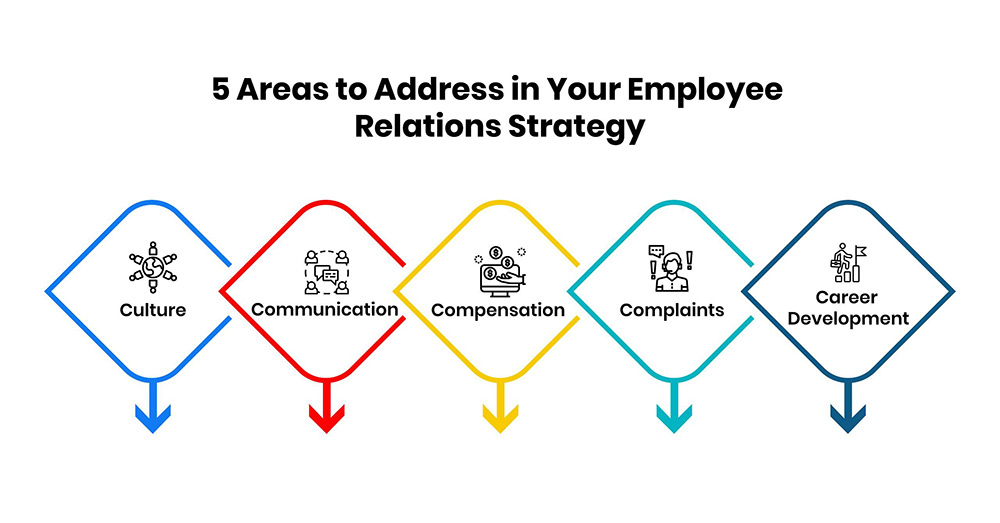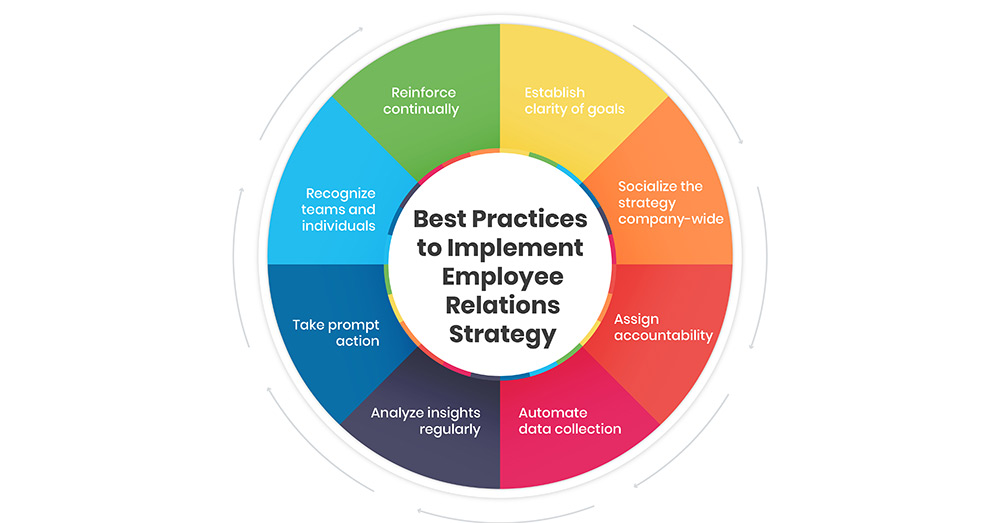Building a Strong Employee Relations Strategy Using Key Performance Indicators
September 19, 2024

Building strong employee relations and a collaborative workplace culture has never been more important. In today’s highly competitive environment for talent, companies must focus on attracting and retaining top performers by creating an enjoyable work experience where individuals can grow their skills and thrive both professionally and personally.
While a pleasant work environment alone isn’t enough, having substantive employee relations and human resources (HR) programs in place helps establish an organization as an employer of choice. However, these initiatives mean little without concrete metrics to evaluate their impact and ensure goals are being achieved.
This is where developing a robust employee relations strategy combined with measurable HR metrics comes into play. By establishing clear objectives, implementing focused programs and activities, and closely tracking relevant data points, you can optimize relationships between employees and management while driving business outcomes.
This comprehensive guide will explore how to create an effective employee relations strategy anchored by meaningful metrics. We’ll look at priority areas to address, recommended key performance indicators (KPIs) to adopt, and steps to refine your approach over time based on gathered insights.
Understanding Employee Relations
Before diving into metrics, it’s important to understand what precisely is meant by employee relations. At its core, employee relations involve proactively building and maintaining positive relationships between a company and its workers. This encompasses the full employment experience from recruiting and onboarding to ongoing development, engagement, and offboarding.
Effective employee relations aim to foster mutual understanding and respect between all parties. It creates a psychologically and physically safe environment where individual needs are balanced with business objectives. The goal is for all employees to feel respected, included, and able to bring their best selves to work each day, so they remain motivated, and productive members of the team.
Areas to Address in Your Employee Relations Strategy
With employee relations defined, the next step is assessing priority areas to focus your strategy on and tailor suitable metrics around. Consider evaluating these five core components regularly:

-
Culture - Examine how your company culture is perceived and lived. Look at factors like overall morale, alignment with company values, inclusiveness, work-life integration etc.
-
Communication - Assess different communication channels and gather feedback on their effectiveness. Ensure employees feel well-informed about organizational changes, events etc.
-
Compensation - Benchmark your total rewards package including pay, benefits and other incentives against market standards. Analyze the impact on retention and satisfaction.
-
Complaints - Track the number and types of complaints or grievances. Monitor resolution timeframes and employee perception of fairness.
-
Career Development - Evaluate available learning and growth opportunities. Analyze participation in training programs and sentiments regarding performance management.
Recommended Employee Relations Metrics
With target areas of focus determined, the next essential piece is selecting concrete metrics to collect relevant data and quantify progress over time. Here are some highly recommended KPIs to consider across the five core components:
Culture Metrics
-
Employee Net Promoter Score (eNPS)
-
Employee engagement survey participation rate
-
Diversity, equity and inclusion survey scores
Communication Metrics
-
Time to respond to employee communications or messages
-
Employee feedback survey questions on internal communications
-
Usage and feedback on various collaborative workplace tools
Compensation Metrics
-
Voluntary attrition rate
-
Compensation competitiveness benchmark against market pay
-
Rewards and recognition program participation rates
Complaints Metrics
-
Number of complaints or grievances raised per month/quarter
-
Average time to resolve complaints
-
Employee survey feedback on the complaint resolution process
Career Development Metrics
-
Training and development budget as % of payroll
-
Participation rate in continual skills-building programs
-
Employee feedback on performance management and growth discussions
Implementing Your Employee Relations Strategy
With focus areas identified and key metrics selected, the next fundamental step is implementing your tailored employee relations strategy. Here are some best practices to keep in mind:

-
Establish clarity of goals.
The first step to implementing your employee relations strategy is to establish clarity of goals. Make sure your employee relations goals are specific, measurable, achievable, relevant and time bound. For example, instead of the vague goal of "improving employee satisfaction", have a goal such as "increase the overall employee satisfaction score from the annual survey by 5% within the next 12 months". Well-defined goals will help you effectively measure the success of your strategy.
-
Socialize the strategy company-wide.
Second, it is important to socialize the strategy company-wide. The employee relations strategy must be clearly communicated to all employees, so they understand how it supports both business objectives and their individual success. Communicate the goals, key focus areas and metrics of the strategy through multiple channels.
Have your employee relations lead or team hold live presentations and Q&A sessions to discuss the strategy. Send out organization-wide emails and put relevant information on your internal messaging platforms and websites. Using diverse communication methods will help ensure everyone is on the same page about the strategy.
-
Assign accountability.
Third, accountability must be assigned for executing the strategy. Designate an employee relations lead, such as the head of your employee relations department, or constitute an employee relations team to spearhead the efforts. Define their specific responsibilities to drive the implementation of initiatives based on the strategy and measure the relevant metrics. Giving clear ownership and responsibilities will help stay organized and keep progress accountable.
-
Automate data collection.
Fourth, automate the collection of as much data as possible using HR and people analytics tools. Leverage platforms that can simplify the ongoing collection of metrics related to focus areas like employee engagement, satisfaction, attrition rates, etc. Automated data collection saves time and reduces manual errors compared to spreadsheets and forms. Integrate pulse surveys and feedback collection into existing workflows using single sign-on options where possible.
-
Analyze insights regularly.
Fifth, schedule periodic structured reviews to analyze metric insights. For example, conduct quarterly reviews where the employee relations lead or team presents a trend analysis of relevant KPIs to managers from different departments. Identify any concerning patterns in feedback, issues raised or metrics that are off targets. Collaboratively discuss potential causes and priority actions to address them. Evidence-based reviews will help objectively assess progress and course-correct strategically.
-
Take prompt action.
Sixth, after identifying red flags or areas for improvement, prioritize and take prompt action. Set deadlines and assign clear responsibilities for addressing issues within predefined timeframes. For urgent matters affecting employee experience or culture, take action within days or weeks. But also establish longer-term initiatives or change management work streams for continuous enhancement based on strategy. Taking action shows commitment and engagement with the strategy.
-
Recognize teams and individuals.
Seventh, make efforts to formally acknowledge and celebrate teams and individuals demonstrating outstanding support for the strategy. Recognize high performers supporting culture changes, driving participation in new programs or consistently exemplifying desired behaviors. Public recognition keeps morale high and motivates others to contribute equally. Link rewards to metrics whenever possible for added incentive.
-
Reinforce continually.
Finally, reinforce the strategy on an ongoing basis. Briefly discuss relevant insights, successes and ongoing focus areas during recurring staff meetings. Highlight exemplary behavior through internal communications. During company-wide celebration events, have the leadership reiterate commitment to the values and focus areas of the strategy. Consistent reminders maintain enthusiasm, hold teams and managers accountable and keep the strategy top-of-mind organically over time.
Following these steps will help you execute the employee relations strategy effectively and achieve your planned organizational outcomes. Periodic evaluation and refinement will also determine ways to further optimize the strategy based on evolving business needs and workforce feedback.
Monitoring the Progress of Your Employee Relations Strategy
With implementation underway, the next crucial step is monitoring ongoing progress and the evolution of your employee relations strategy over time based on gathered metrics. Consider the following best practices:
-
Establish recurring review cadence. Schedule structured strategy reviews quarterly or bi-annually.
-
Compare metrics to targets and benchmarks. Analyze variances from goals set and market standards.
-
Identify positive and negative drivers. Understand factors heavily influencing key metrics trends.
-
Spotlight success stories. Highlight business units, functions or roles excelling in certain focus areas.
-
Prioritize remedial action. Address significantly underperforming metric areas requiring intervention.
-
Adjust goals and priorities. Refine strategy aspects not achieving intended impact through measurable goals.
-
Recalibrate metrics definition. Refine metric questions, calculations or benchmarks not providing clear insights.
-
Recognize and reward. Formally acknowledge high-performing contributors quarterly or annually.
-
Communicate progress transparently. Share periodic updates with all teams to reinforce strategic alignment.
Enhancing Your Employee Relations Strategy
An effective employee relations strategy is an ongoing journey versus a one-time project. Rigorous monitoring allows you to evolve the approach continually based on a data-driven understanding of changing dynamics. Here are some additional enhancement activities to undertake:
-
Conduct employee listening tours. Gather qualitative sentiment via small group discussions to contextualize metrics.
-
Administer ad-hoc pulse surveys. Quickly understand reactions to critical organizational changes impacting culture.
-
Analyze metrics against industry benchmarks. Track relativity to sector peers on compensation, attrition etc.
-
Audit internal policies and processes. Ensure alignment to strategy goals and inclusive, compassionate philosophies.
-
Outsource specialist expertise. Supplement in-house skills via external advisors for complex employee relations cases.
-
Partner with professional networks. Access peer perspectives, global surveys and research via employer brand associations.
-
Automated reporting of metrics. Produce auto-scheduled, easy-to-consume analytics reports for ongoing oversight.
-
Introduce feedback apps. Pilot conversational tools via intranet/chatbots to continuously capture perspectives.
-
Track external reviews and employer branding. Analyze aggregator platforms and benchmark positive sentiment changes over quarters.
Sustaining Momentum Behind Your Strategy
With ongoing enhancements in place, a structured communication approach can help maintain momentum behind your impactful employee relations strategy backed by measurable metrics. Consider these best practices:
-
Publish case studies showcasing notable successes on the intranet and in company newsletters.
-
Highlight employee relations goals, priorities and key insights during all-hands company presentations.
-
Feature strategy ‘champions’ through company profile articles or digital stories about their roles and impacts.
-
Recognize and reward top business units demonstrating the most marked improvements in focus areas.
-
Publish data visualizations of metrics in common areas for quick understanding of trends company wide.
-
Feature employee relations in your annual report or shared with external partners as a competitive differentiator.
-
Incorporate strategy goals into relevant manager OKRs and individual performance objectives.
-
Rotate employee relations information displays or posters across office spaces on a bi-monthly schedule.
With the right strategic focus, continuous measurement and sustained communication, your company can foster caring, collaborative relationships between employees and leaders that ultimately translate into positive impacts for both people and business performance.
Conclusion
A structured and data-driven approach to employee relations encompassing well-defined goals, activities and evaluation metrics paves the way for success. Regular reviews and course corrections ensure continuous evolution and optimization. With the right strategy in place, organizations can drive higher engagement, productivity and talent retention.


